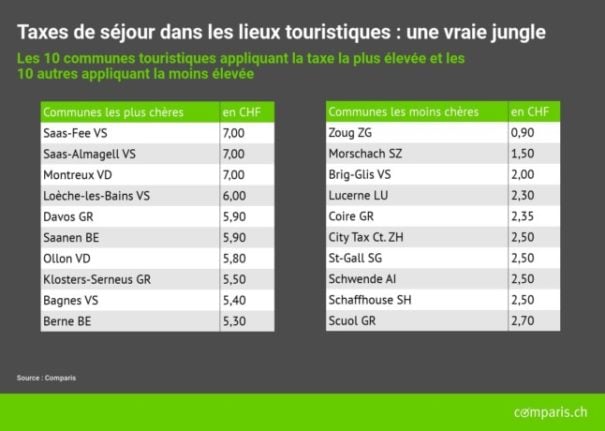Even on a holiday you won’t be able to escape taxes.
Tourist taxes — fees levied on guests by hotels and other accommodation providers — are used to finance infrastructure and facilities in the community.
Paying the tourist tax can also entitle you to use some facilities in the regions, such as public transport and visiting cultural sites.
They are added to the room invoice and have to be paid at the end of the stay.
But depending on where you go and how long you stay at your destination, these charges can take a big chunk out of your vacation budget.
This is the finding of a new study by Swiss consumer site Comparis.ch, which compared taxes in 80 municipalities most frequented by tourists.
In Switzerland, the average amount of this tax for an adult is 3.75 francs per night. But this figure masks great regional disparities, Comparis reported.
As the chart below shows, taxes range from the lowest, 90 cents per night in Zug, to the most expensive — a hefty 7-franc nightly fee in the Valais communities of Saas-Fe and Saas- Almagel, as well as in Montreux, Vaud.

On the other hand Zurich, which is Switzerland’s most expensive city and among the priciest in the world, is below the national average, at 2.50 francs a night.
READ MORE: EXPLAINED: Why are major Swiss cities so expensive?
Interestingly, there are significant disparities even among communes in the same canton.
For instance, while in Saas-Fe and Saas- Almagel tourist tax is 7 francs nightly, it is only 2 francs in Brig-Glis.
And Davos in Graubünden charges 5.90 a night, while in Scuol, located in the same canton, this fee is 2.70.
But hotels are not to blame, as these fees are set by municipalities, not by accommodation companies.
Leo Hug, from Comparis, said a major reason for the significant differences is that village politicians usually set the rates without taking other areas into account.
Even if a high tourist tax rate is charged, local residents are unlikely to object as the tax hikes do not directly affect them, Comparis finds.
While the amounts do not seem significant, over a period of time the small amounts do add up – especially for families.
A family of four holidaying in Saas-Fe for a week would be liable to pay 140 francs.
Swiss news agency Watson reports that some municipalities have decided however to scrap the tourist tax, including Andermatt (Uri), Celerina, Flims and Val Müstair (Grisons) and Engelberg (Obwalden).
READ MORE: UPDATED: Who can travel to Switzerland right now?




 Please whitelist us to continue reading.
Please whitelist us to continue reading.
Member comments